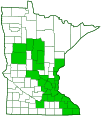oak leaf gall midge
(Polystepha pilulae)
Conservation • Description • Habitat • Ecology • Distribution • Taxonomy
|
|
|||||||||||||
Description |
Oak leaf gall midge is a long-legged, 1 ⁄16″ to ⅛″ long, mosquito-like fly (midge). The abdomen has ten segments, each covered with upper (dorsal) and lower (ventral) exoskeletal plates. On the female the seventh lower plate (sternite) is much longer than the sixth; and the eighth upper plate (tergite) is wide, strongly hardened, and laterally notched. The wings are clear, are covered with hairs, and have reduced venation. Only four veins reach the wing margin. The basal segment of the foot (tarsus) is much shorter than the second segment. The mouth parts are reduced. The large compound eyes meet at the top of the head. There are no simple eyes (ocelli). The antennae are long and have 12 segments. On the female these segments are cylindrical. Adults are impossible to identify by appearance in the field. However, the species can easily be identified by the gall it produces. Galls appear always on the upper surface of northern pin oak, northern red oak, and possibly black oak leaves. They are hard, 1 ⁄16″ to 3 ⁄16″ in diameter, and irregular in shape. They are green when they first appear in the spring, soon turning red or magenta. As they age they become brown and crusty. They can be easily detached from the leaf surface. The larva is bright orange. |
Size |
Gall: 1 ⁄16″ to 3 ⁄16″ |
Similar Species |
Blackjack oak leaf gall midge (Polystepha globosa) forms similar spherical galls on the undersurface of the leaves of black oak and possibly other oaks in the red oak group. |
Habitat and Hosts |
Northern pin oak, northern red oak |
Ecology |
Season |
Autumn |
Behavior |
|
Life Cycle |
Larvae break out of the gall in the fall and reproduce before reaching maturity. |
Larva Hosts |
Northern pin oak, northern red oak, and possibly black oak |
Adult Food |
|
Distribution |
||
|
Sources |
|
| 7/26/2025 | ||
Occurrence |
||
Common |
||
Taxonomy |
|
Order |
|
Suborder |
Nematocera |
Infraorder |
Bibionomorpha (gnats and allies) |
Superfamily |
Sciaroidea (fungus gnats and gall midges) |
Family |
|
Subfamily |
Cecidomyiinae (gall midges) |
Supertribe |
Cecidomyiidi |
Tribe |
Asphondyliini |
Subtribe |
Schizomyiina |
Genus |
Polystepha |
Subordinate Taxa |
|
|
|
Synonyms |
|
Cecidomyia pilulae Cincticornia pilulae |
|
Common Names |
|
oak leaf gall oak leaf gall midge pin oak gall red oak gall |
|
Glossary
Gall
An abnormal growth on a plant produced in response to an insect larva, mite, bacteria, or fungus.
Midge
A small fly, somewhat resembling a mosquito, in one of several families in the suborder Nematocera.
Ocellus
Simple eye; an eye with a single lens. Plural: ocelli.
Visitor Photos |
||
Share your photo of this insect. |
||
This button not working for you? |
||
Vanessa Sheldon |
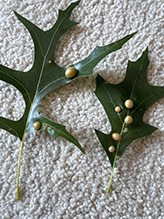 |
these are covering my pin oak tree leaves |
2mevon |
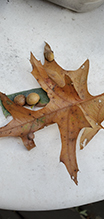 |
Luciearl |
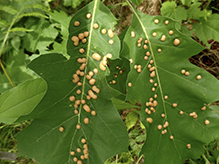 |
Galls Bright color (not captured in photo) to these formations on oak leaves. |
MinnesotaSeasons.com Photos |
||
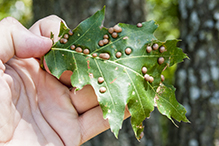 |
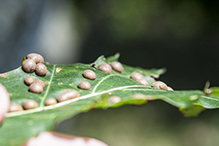 |
|
Leaf upperside |
Lateral veiw |
|
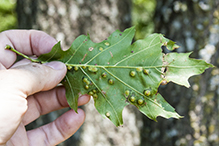 |
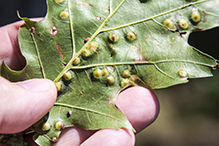 |
|
Leaf underside |
Leaf underside | |
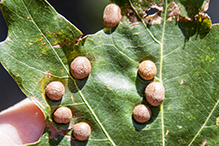 |
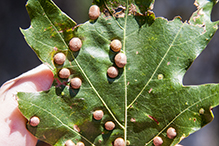 |
|
Galls |
Galls | |
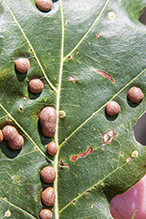 |
||
| Galls |
|

Slideshows |
|

Visitor Videos |
||
Share your video of this insect. |
||
This button not working for you? |
||
|
Other Videos |
||
|

Visitor Sightings |
||
Report a sighting of this insect. |
||
This button not working for you? |
||
Vanessa Sheldon |
Location: Victor, NY in Monroe County these are covering my pin oak tree leaves |
 |
Karen Frances |
Location:1730 East Elm St, Jefferson City, MO This is the second year for these critters on this same tree. |
|
Sheila Muise |
Location: Boston, Ontario |
|
Evie Knapp |
Location: Orono, MN 55359 I have seen this on a few leaves on our oak tree and am wondering if it will do damage to the tree! |
|
John Valo |
Not according to University of Missouri Extension: Those unsightly round, brown growths seen on oaks this time of year won’t harm the tree, says a University of Missouri Extension fruit specialist. |
|
Luciearl |
Location: Cass County Bright color (not captured in photo) to these formations on oak leaves. |
 |
MinnesotaSeasons.com Sightings |
||

Created: 12/23/2015 Last Updated: © MinnesotaSeasons.com. All rights reserved. |
